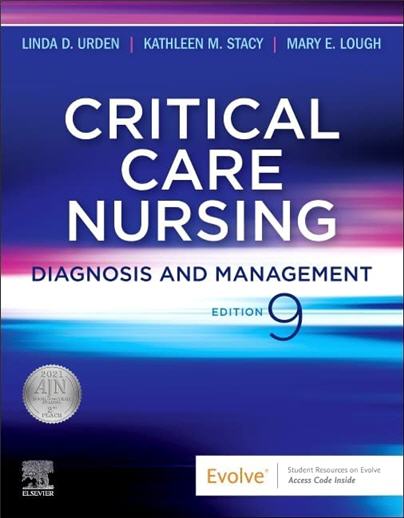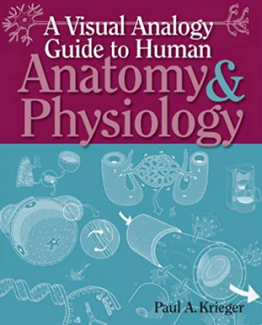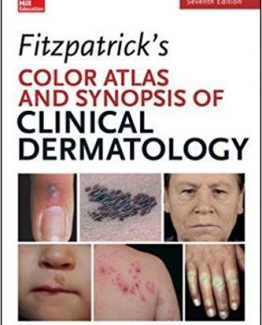Critical Care Nursing: Diagnosis and Management 9th Edition by Linda D. Urden, ISBN-13: 978-0323642958
[PDF eBook eTextbook]
- Publisher: Elsevier; 9th edition (March 25, 2021)
- Language: English
- 1136 pages
- ISBN-10: 0323642950
- ISBN-13: 978-0323642958
Winner of the 2nd-place American Journal of Nursing Book of the Year award in emergency/critical care nursing for 2021!
Prepare for success in today’s high acuity, progressive, and critical care settings! Critical Care Nursing: Diagnosis and Management, 9th Edition helps you understand and apply critical care nursing principles and concepts to clinical assessment, diagnostic procedures, and therapeutic management. Known for its comprehensive coverage, this leading textbook uses a logical, body systems organization to address the care of patients with physiological alterations. New to this edition are illustrated Patient-Centered Critical Care features aimed at “humanizing the ICU” as well as Next Generation NCLEX® Exam–style case studies to help you further develop your clinical judgment skills and prepare for the latest nursing licensure exam. Also ideal for CCRN® and PCCN® exam preparation, this book is a one-stop resource on the concepts and skills required for critical care nursing!
- Time-tested, high-quality content addresses all aspects of today’s high acuity, progressive, and critical care nursing.
- Consistent organization within each body-system unit provides an efficient framework for learning, for CCRN® and PCCN® certification preparation, and for reference in clinical practice.
- Comprehensive, evidence-based content is highly referenced and includes internet resources for further research and study.
- Enhanced Quality and Safety Education for Nurses (QSEN) integration links text content to QSEN competencies, through the addition of QSEN-related questions in case studies, QSEN-labeled features and boxes, QSEN content icons, and highlighted QSEN information.
- NEW! Updated content throughout reflects the latest changes in concepts, techniques, and technology of high acuity, progressive, and critical care nursing.
- NEW! New Facilitating Care Transitions chapter explains how critical care nurses can ensure patient safety and provide family education through all phases and locations of care, during transitions to other units and departments within the facility, and during patient discharge to various sites (e.g., home, hospice, long-term care).
- NEW! Illustrated Patient-Centered Critical Care boxes highlight a new emphasis on changing the culture of critical care by greater inclusion of the patient and family, with evidence-based discussions of topics such as family meetings, debriefing after a code, patient diaries, creating a calm environment, pet visitation, music therapy, the transition of care, and 24/7 ICU visitation.
- NEW! 10 Next Generation NCLEX® Exam–style case studies are provided on the Evolve website to help prepare you for the changes in the nursing licensure exam.
- NEW! Diagnosis and Patient Care Management boxes reflect a new focus on the International Classification of Nursing Practice (ICNP), providing a common language for patient problems using the evidence-based ICNP taxonomy.
- NEW! Expanded coverage of key trends includes the use of personal protective equipment in light of the global COVID-19 pandemic, the opioid epidemic, special considerations for bariatric patients, oncology, and acute chest syndrome.
- NEW! Additional coverage of the technology required to monitor the patient and other interprofessional team members assists in the management of the patient and the integration of other QSEN competencies.
- NEW! Psychosocial and Spiritual Considerations chapter emphasizes the psychosocial and spiritual wellbeing of critical care clients.
- NEW! Expanded coverage of self-care for healthcare professionals equips new critical care nurses to take the time to care for themselves as well as for their patients.
- NEW! Updated illustrations improve understanding.
- NEW! Key Points replace Chapter Summary features for quick reference and study.
Table of Contents:
UNIT 1: FOUNDATIONS OF CRITICAL CARE NURSING
1. Critical Care Nursing Practice
2. Ethical Issues
3. Legal Issues
4. Genetic Issues
5. Facilitating Care Transitions New title/focus!
6. Psychosocial and Spiritual Considerations New title/focus!
7. Nutrition Alterations and Management New title/focus!
8. Pain and Pain Management
9. Sedation, Agitation, and Delirium Management
10. Palliative and End-of-Life Care
UNIT 2: CARDIOVASCULAR ALTERATIONS
11. Cardiovascular Anatomy and Physiology
12. Cardiovascular Clinical Assessment
13. Cardiovascular Diagnostic Procedures
14. Cardiovascular Disorders
15. Cardiovascular Therapeutic Management
UNIT 3: PULMONARY ALTERATIONS
16. Pulmonary Anatomy and Physiology
17. Pulmonary Clinical Assessment
18. Pulmonary Diagnostic Procedures
19. Pulmonary Disorders
20. Pulmonary Therapeutic Management
UNIT 4: NEUROLOGIC ALTERATIONS
21. Neurologic Anatomy and Physiology
22. Neurologic Clinical Assessment and Diagnostic Procedures
23. Neurologic Disorders and Therapeutic Management
UNIT 5: KIDNEY ALTERATIONS
24. Kidney Anatomy and Physiology
25. Kidney Clinical Assessment and Diagnostic ProceduresÂ
26. Kidney Disorders and Therapeutic Management
UNIT 6: GASTROINTESTINAL ALTERATIONS
27. Gastrointestinal Anatomy and Physiology
28. Gastrointestinal Clinical Assessment and Diagnostic Procedures
29. Gastrointestinal Disorders and Therapeutic Management
UNIT 7: ENDOCRINE ALTERATIONS
30. Endocrine Anatomy and Physiology
31. Endocrine Clinical Assessment and Diagnostic Procedures
32. Endocrine Disorders and Therapeutic Management
UNIT 8: MULTISYSTEM ALTERATIONS
33. Trauma
34. Shock, Sepsis, and Multiple Organ Dysfunction Syndrome
35. Burns
36. Organ Donation and Transplantation
37. Hematologic and Oncologic Emergencies
UNIT 9: SPECIAL POPULATIONS
38. The Obstetric Patient
39. The Pediatric Patient
40. The Older Adult Patient
Appendix A: Patient Care Management Plans
Appendix B: Physiologic Formulas for Critical Care
Appendix C: Canadian/SI Units
Special Features
Index
What makes us different?
• Instant Download
• Always Competitive Pricing
• 100% Privacy
• FREE Sample Available
• 24-7 LIVE Customer Support






Reviews
There are no reviews yet.